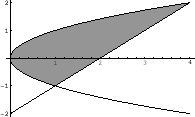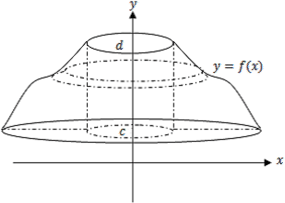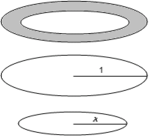Next: Application of Definite Integrals Up: Integration Previous: Evaluating Definite Integral Contents Index
The definite integral we have studied so far can only apply to the continuous functions. Now we extend this definition to the function with finite number of discontinuity.
| Improper Integral of the 1st kind |
|---|
[1] If  is continuous on is continuous on ![$(a,b]$](img3223.png) and discontinuous at and discontinuous at  . Then . Then  is continuous on the interval is continuous on the interval
![$[a + \varepsilon, b]$](img3226.png) . Thus we can think of the following definite integral . Thus we can think of the following definite integral


 is continuous on is continuous on  and discontinuous at and discontinuous at  . Then . Then  is continuous on the interval is continuous on the interval
![$[a, b - \varepsilon]$](img3230.png) . Thus we can think of the following definite integral . Thus we can think of the following definite integral


|
1.
 2.
2.

 . Then
. Then  and
and
 .
.
 ,
,
 |
 |
![$\displaystyle \int_1^0\frac{-2udu}{u} = \int_0^1 \frac{2}{u}du = \lim_{\varepsi...
...\varepsilon \to 0+}\left[2t\right]_\varepsilon^1 = 2\ensuremath{\ \blacksquare}$](img3240.png) |
 is continuous on
is continuous on ![$(0,1]$](img3242.png) and antiderivative of
and antiderivative of  is
is  .
.
 |
 |
 |
|
 |
 |
 2.
2.

SOLUTION 1.
 is continuous on
is continuous on ![$(0,e]$](img3253.png) , but discontinuous at
, but discontinuous at  . Let
. Let
 . Then
. Then
 ,
,
 ,
,

 is not continuous at
is not continuous at  .
.
 |
 |
![$\displaystyle \lim_{\varepsilon \to 0+}\int_\varepsilon^1 \frac{1}{t}dt = \lim_...
...}\right]_{\varepsilon}^1 = \log{1} - \lim_{\varepsilon \to 0+}\log{\varepsilon}$](img3261.png) |
|
 |
 |
 is continuous on
is continuous on
 , but not continuous at
, but not continuous at  . Then we write
. Then we write


Improper Integral of the 1st kind
[3]  is discontinuous at
is discontinuous at
![$c_{1},c_{2},\ldots,c_{n} \in [a,b
]$](img3275.png) . Then divide the interval
. Then divide the interval ![$[a,b]$](img1084.png) into subintervals
into subintervals
![$[a,c_{1}],[c_{1},c_{2}],\ldots,[c_{n},b]$](img3276.png) . Now consider the improper imtegral on each subintervals. If all improper integrals exist, then we define the sum of improper integrals as improper integral of
. Now consider the improper imtegral on each subintervals. If all improper integrals exist, then we define the sum of improper integrals as improper integral of  on
on ![$[a,b]$](img1084.png) .
.


 is not continuous at
is not continuous at  . Then we write
. Then we write

![$\displaystyle \int_{0}^{1}\frac{1}{x^2}\:dx = \lim_{\varepsilon \to 0+}\int_{\v...
...on \to 0+}\left[-\frac{1}{x}\right]_{\varepsilon}^{1} = -(1 - \infty) = \infty.$](img3281.png)



 is not continuous at
is not continuous at  . Then we write the integral as follows:
. Then we write the integral as follows:

![$\displaystyle \int_{-1}^{0}\frac{1}{x^{2/3}}\:dx = \lim_{\varepsilon \to 0-}\in...
...im_{\varepsilon \to 0-}\left[3x^{1/3}\right]_{-1}^{\varepsilon} = 0 - (-3) = 3.$](img3289.png)
 . Thus we can conclude that no improper integral exists
. Thus we can conclude that no improper integral exists

| Improper Integral of the 2nd kind |
|---|
 is continuous on is continuous on
 . Then . Then  is continuous on is continuous on ![$[a,b]$](img1084.png) , where , where
 . Then we define the infinite integral using the limit of . Then we define the infinite integral using the limit of
 . .

 is continuous on is continuous on
![$(-\infty,b]$](img3296.png) . .

|

 ,
,
 |
 |
![$\displaystyle \lim_{b \to \infty}\int_{1}^{b}\frac{1}{x^{p}}\:dx = \lim_{b \to ...
...}\int_1^b x^{-p}\:dx = \lim_{b \to \infty}\frac{1}{1-p}\left[x^{1-p}\right]_1^b$](img3304.png) |
|
 |
![$\displaystyle \lim_{b \to \infty} \frac{1}{1-p}(b^{1-p} - 1) = \left\{\begin{array}{cl}
\frac{1}{p-1}, & p > 1\\
\infty, & p < 1
\end{array}\right].$](img3305.png) |
 ,
,

If  is continuous on
is continuous on
 and
and
 exists, then we express this limit
exists, then we express this limit
 .
.

 |
 |
![$\displaystyle \lim_{{a \rightarrow -\infty}, {b \rightarrow \infty}}\int_{a}^{b...
...{1+x^{2}} = \lim_{a \to -\infty, b \to \infty}\left[\tan^{-1}{x}\right]_{a}^{b}$](img3313.png) |
|
 |
 |
Proof
1.
Gamma Function
Let
 . Then
. Then

 is natural number
is natural number






Using integration by parts,

 |
 |
![$\displaystyle \lim_{b \to \infty}\left[x^{n}(-e^{-x}) \right ]_{0}^{b} - \lim_{b \to \infty}\int_{0}^{b}nx^{n-1}(-e^{-x}) dx$](img3325.png) |
|
 |
![$\displaystyle \lim_{b \to \infty}\left[-x^{n}(e^{-x}) \right ]_{0}^{b} + n\lim_{b \to \infty}\int_{0}^{b}x^{n-1}(e^{-x}) dx$](img3326.png) |
||
 |
 |
 , we use the Maclaurin series expansion of
, we use the Maclaurin series expansion of  .
.


2. By 1. for  , we have the recurrence relation
, we have the recurrence relation
 .
.

 |
 |
![$\displaystyle \int_{0}^{\infty}e^{-x} dx = \lim_{b \to \infty}\int_0^b e^{-x}dx...
...lim_{b \to \infty}\left[-e^{-x}\right]_0^b = -\lim_{b \to \infty}e^{-b} + 1 = 1$](img3337.png) |

 . Then let
. Then let
 . Then
. Then  ,
,
 .
.
 . Thus,
. Thus,
 |
 |
 |
 . Thus
. Thus

|
Exercise A
|
|
Exercise B
|
 is called the complete elliptic integral of the 1st kind?DLet
is called the complete elliptic integral of the 1st kind?DLet
 be the arithmetic mean. Then the following is known?D
be the arithmetic mean. Then the following is known?D

 ?D
?D